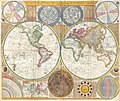Dosiero:1794 Samuel Dunn Wall Map of the World in Hemispheres - Geographicus - World2-dunn-1794.jpg

Grandeco de ĉi antaŭvido: 712 × 600 rastrumeroj. Aliaj distingivoj: 285 × 240 rastrumeroj | 570 × 480 rastrumeroj | 912 × 768 rastrumeroj | 1 216 × 1 024 rastrumeroj | 2 431 × 2 048 rastrumeroj | 6 000 × 5 054 rastrumeroj.
Bildo en pli alta difino ((6 000 × 5 054 rastrumeroj, grandeco de dosiero: 8,92 MB, MIME-tipo: image/jpeg))
Dosierhistorio
Alklaku iun daton kaj horon por vidi kiel la dosiero tiam aspektis.
| Dato/Horo | Bildeto | Grandecoj | Uzanto | Komento | |
|---|---|---|---|---|---|
| nun | 20:01, 1 jun. 2012 |  | 6 000 × 5 054 (8,92 MB) | Brandmeister~commonswiki | Reverted to version as of 04:17, 23 March 2011 |
| 16:15, 19 maj. 2012 |  | 6 000 × 5 054 (27,38 MB) | Brandmeister~commonswiki | contrast | |
| 04:17, 23 mar. 2011 |  | 6 000 × 5 054 (8,92 MB) | BotMultichillT | {{subst:User:Multichill/Geographicus |link=http://www.geographicus.com/P/AntiqueMap/World2-dunn-1794 |product_name=1794 Samuel Dunn Wall Map of the World in Hemispheres |map_title=A General Map of the World, or Terraqueouis Globe with all the New Discover |
Dosiera uzado
La jena paĝo ligas al ĉi tiu dosiero:
Suma uzado de la dosiero
La jenaj aliaj vikioj utiligas ĉi tiun dosieron:
- Uzado en alt.wikipedia.org
- Uzado en ar.wikipedia.org
- Uzado en av.wikipedia.org
- Uzado en br.wiktionary.org
- Uzado en ckb.wikipedia.org
- Uzado en cv.wikipedia.org
- Uzado en de.wikipedia.org
- Uzado en en.wikipedia.org
- Early world maps
- History of cartography
- Southern Ocean
- Samuel Dunn (mathematician)
- Wikipedia:Featured picture candidates/1794 Samuel Dunn Map
- A General Map of the World, or Terraqueous Globe
- Wikipedia:Featured picture candidates/June-2012
- User:Cruickshanks/sandbox2
- Wikipedia:Featured picture candidates/March-2014
- Wikipedia:Featured picture candidates/1794 Samuel Dunn Wall Map of the World in Hemispheres - Geographicus - World2-dunn-1794.jpg (review)
- User:Setvina/be bold
- Portal:Maps
- User:Sarangem
- User:Jacobwilder427
- Uzado en en.wiktionary.org
- Uzado en et.wikipedia.org
- Uzado en eu.wikipedia.org
- Uzado en fa.wikipedia.org
- ویکیپدیا:نگارههای برگزیده/نقشه
- ویکیپدیا:گزیدن نگاره برگزیده/ژوئن-۲۰۱۲
- نقشه ساموئل دان
- ویکیپدیا:گزیدن نگاره برگزیده/1794 Samuel Dunn Wall Map of the World in Hemispheres - Geographicus - World2-dunn-1794.jpg
- ویکیپدیا:نگاره روز/اکتبر ۲۰۱۲
- الگو:نر/2012-10-03
- الگو:نر محافظت شده/2012-10-03
- بحث کاربر:Alborzagros/بایگانی ۷
- Uzado en fr.wikipedia.org
- Uzado en fr.wikiversity.org
- Uzado en gl.wikipedia.org
- Uzado en hu.wikipedia.org
- Uzado en hy.wikipedia.org
- Uzado en id.wikipedia.org
Vidi plian ĝeneralan uzadon de ĉi tiu dosiero.
